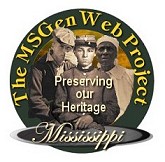
Pontotoc County, Mississippi
Genealogy and History
Peggy A. Young, County CoordinatorJeff Kemp - State Coordinator Denise Wells - Assistant State Coordinator
Ann Allen Geoghegan - Assistant State Coordinator
Sunday, 13-Jun-2010 13:43:55 EDT

W. P. A. History of Pontotoc County, Mississippi
Chapter II: Topography
Soil Types
The county is divided into three distinct areas with reference to soil types and topography.. A certain area in the western half is known as the FLATWOODS, so called because it is largely flat, with very few hills, and the water-level is near the surface. Erosion and occasional gullies are found over practically all of the area. In this particular section, drainage is as pronounced a problem as erosion.
A section in the eastern half of the county, known as PONTOTOC RIDGE is made up of steep hills and bluffs, of which many are in cultivation or in use as pastures. Some of the area is bare of vegetation, having been divested of such by large gullies and sheet erosion. Great damage is also down by the water that rushes down the hillside gullies, carrying tons of sand and clay and depositing it on fertile farm land. The results are more overflows, crop failures, and ruined acreage.
The PRAIRIE BELT touches the southeastern part of the county. This is a rich fertile part of the county, which produces fine crops of hay (see chap. 15 Agriculture). (1)
A narrow strip of low, flat land borders Pontotoc Ridge on the west and sweeps in an open crescent around the western and southern margin of the Black Prairies. It is so much lower than bordering areas, and so distinctly marked off, and its surface so nearly featureless in its typical phase, that it has been called the FLATWOODS by settlers. It was likened by Crider to a broad river bottom.
At a point where Calhoun and Lafayette counties join Pontotoc on the southwest corner, there is a rugged region which extends from Lochinvar, by Troy, to the part of the county known as Buncombe Hills, between Ecru and Sherman, beginning at Oakhill, twelve miles northeast of Pontotoc. (2)
(1)Dr. R. P. Donaldson, Pontotoc, Miss.
E. N. Lowe, Mississippi State Geological Survey Bulletin No. 20, 1925
(2) Ibid.
Back Contents Next